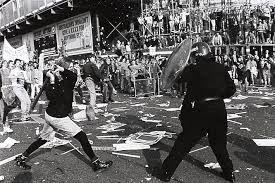
Exactly 25 years ago today, the biggest and most famous of all poll tax riots occurred in London. On a mild, sunny afternoon 200,000 people marched from Hyde Park to Trafalgar Square to protest against the iniquitous tax.
A large group of protesters were penned in when police blocked the top and bottom of Whitehall. After several heavy-handed arrests, a series of scuffles broke out as people tried to break through police lines and march to Trafalgar Square.
Serious rioting began when mounted police attacked crowds in Trafalgar Square. Police vans came under attack after they were driven at demonstrators to disperse them. Builder’s cabins in the square were set on fire, as were parts of the South African Embassy nearby.
Fighting spilled out into the busy streets of the West End and continued into the night. Numerous shops, car showrooms and expensive restaurants and clubs – including Stringfellows – were attacked. Hundreds were reported injured, including many police officers, and 339 demonstrators were arrested.
In context: The community charge – or poll tax as it became known – was the flagship policy of the Thatcher government. Everyone was liable to pay, regardless of income. One of its instigators, environment minister Nicholas Ridley, bragged that a dustman would pay the same as a duke.
The tax was widely unpopular, especially when tax rates set by local councils were much higher than initially predicted. By the end of 1989 there were 1000 Anti-Poll Tax Unions throughout Britain. The APTUs encouraged non-payment, and organised protests and resistance to bailiffs.
As councils held meetings to set their poll tax rates in spring 1990, a series of demonstrations turned into riots. These occurred in London boroughs such as Lambeth and Hackney and in other towns and cities as well. This set the mood for the national march.
What happened next: The riot was widely condemned not only by the Tories but also by Labour and even by the far left Militant Tendency who’d organised the march.
As well as those detained on the day, more than 100 were arrested afterwards due to video and photographic evidence. The Trafalgar Square Defendants Campaign offered unconditional support and video footage it acquired from the police helped get people off trumped up charges.
The popular press had a field day and published “wanted” photos of the protesters. One iconic image showed a masked woman confronting a riot cop. In May the Daily Mail revealed the identity of “Britain’s most wanted poll tax rioter” as 21-year-old Lorraine Vivian after her mother recognised her. She was imprisoned for one year.
During 1990 the poll tax grew in unpopularity and more and more people said “can’t pay, won’t pay”. Margaret Thatcher resigned in November 1990 and her successor John Major announced its replacement by the council tax, which took some account of ability to pay.
An interesting footnote is the link between the anti-poll tax movement and animal rights, which was going through a militant phase of its own. Police said 37 of those arrested “had some form of links” with AR, including one person who was found in possession of incendiary devices after his home was raided.
In March 1991 a rally to mark the anniversary of the riot went ahead as a ”victory parade” instead of a protest. Although rioting in London had received the most attention, it was widespread resistance and non-payment that defeated the state
Leave a Reply